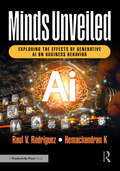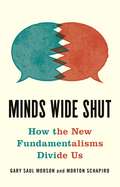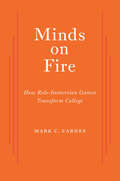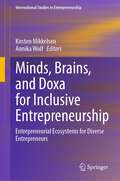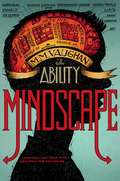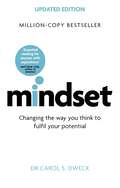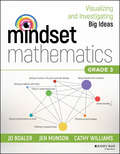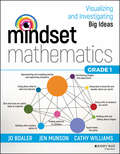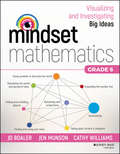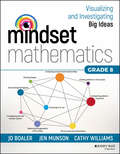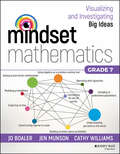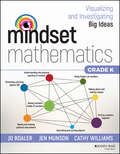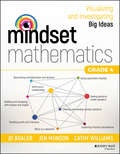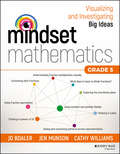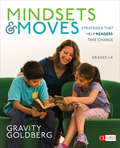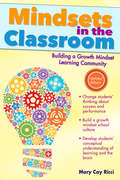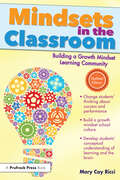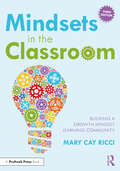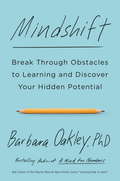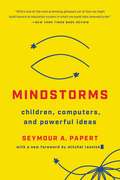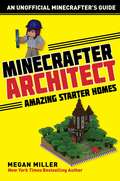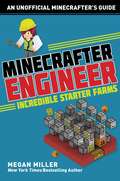- Table View
- List View
Minds Unveiled: Exploring the Effects of Generative AI on Business Behavior
by Hemachandran K Raul V. RodriguezThis book demonstrates how generative artificial intelligence (AI), a form of sophisticated AI technology, is transforming our knowledge of how the human mind functions in relation to business leadership and decision-making. It describes the most recent findings and applications of generative AI in psychology. The book explains the relationships between language, thinking, and behavior as well as how AI may aid in our understanding of learning, decision-making, and problem-solving. In addition, it discusses the significance of applying AI properly and ethically. This book provides a comprehensive overview of how AI is increasing our understanding of the mind and how it impacts each of us professionally.
Minds Wide Shut: How the New Fundamentalisms Divide Us
by Gary Saul Morson Morton SchapiroA timely exploration of intellectual dogmatism in politics, economics, religion, and literature—and what can be done to fight itPolarization may be pushing democracy to the breaking point. But few have explored the larger, interconnected forces that have set the stage for this crisis: namely, a rise in styles of thought, across a range of fields, that literary scholar Gary Saul Morson and economist Morton Schapiro call “fundamentalist.” In Minds Wide Shut, Morson and Schapiro examine how rigid adherence to ideological thinking has altered politics, economics, religion, and literature in ways that are mutually reinforcing and antithetical to the open-mindedness and readiness to compromise that animate democracy. In response, they propose alternatives that would again make serious dialogue possible.Fundamentalist thinking, Morson and Schapiro argue, is not limited to any one camp. It flourishes across the political spectrum, giving rise to dueling monologues of shouting and abuse between those who are certain that they can’t be wrong, that truth and justice are all on their side, and that there is nothing to learn from their opponents, who must be evil or deluded. But things don’t have to be this way. Drawing on thinkers and writers from across the humanities and social sciences, Morson and Schapiro show how we might begin to return to meaningful dialogue through case-based reasoning, objective analyses, lessons drawn from literature, and more.The result is a powerful invitation to leave behind simplification, rigidity, and extremism—and to move toward a future of greater open-mindedness, moderation, and, perhaps, even wisdom.
Minds Wide Shut: How the New Fundamentalisms Divide Us
by Gary Saul MorsonA timely exploration of intellectual dogmatism in politics, economics, religion, and literature—and what can be done to fight itPolarization may be pushing democracy to the breaking point. But few have explored the larger, interconnected forces that have set the stage for this crisis: namely, a rise in styles of thought, across a range of fields, that literary scholar Gary Saul Morson and economist Morton Schapiro call “fundamentalist.” In Minds Wide Shut, Morson and Schapiro examine how rigid adherence to ideological thinking has altered politics, economics, religion, and literature in ways that are mutually reinforcing and antithetical to the open-mindedness and readiness to compromise that animate democracy. In response, they propose alternatives that would again make serious dialogue possible.Fundamentalist thinking, Morson and Schapiro argue, is not limited to any one camp. It flourishes across the political spectrum, giving rise to dueling monologues of shouting and abuse between those who are certain that they can’t be wrong, that truth and justice are all on their side, and that there is nothing to learn from their opponents, who must be evil or deluded. But things don’t have to be this way. Drawing on thinkers and writers from across the humanities and social sciences, Morson and Schapiro show how we might begin to return to meaningful dialogue through case-based reasoning, objective analyses, lessons drawn from literature, and more.The result is a powerful invitation to leave behind simplification, rigidity, and extremism—and to move toward a future of greater open-mindedness, moderation, and, perhaps, even wisdom.
Minds on Fire
by Mark C. CarnesWhy are so many students intellectually disengaged? Faculty, administrators, and tuition-paying parents have been asking this question for nearly two centuries. And the answer is always more or less the same: students are so deeply absorbed in competitive social play (fraternities, sports, beer pong, World of Warcraft, social media) that they neglect academics. In Minds on Fire, Carnes shows how role-immersion games channel studentsâe(tm) competitive (and sometimes mischievous) impulses into transformative learning experiences. His discussion is based on interviews with scores of students and faculty who have used a pedagogy called Reacting to the Past, which features month-long games set during the French revolution, Galileo's trial, the partition of India, and dozens of other epochal moments in disciplines ranging from art history to the sciences. These games have spread to over three hundred campuses around the world, where many of their benefits defy expectations. Students think more critically by internalizing alternative selves, and they understand the past better by filtering it through their present. Fierce competition between opposing sides leads to strong community bonds among teammates and develops speaking, writing, leadership, and problem-solving skills. Minds on Fire is a provocative critique of educational reformers who deplored role-playing pedagogies, from Plato to Dewey to Erikson. Carnes also makes an impassioned appeal for pedagogical innovation. At a time when cost-cutting legislators and trustees are increasingly drawn to online learning, Carnes focuses on how bricks-and-mortar institutions of higher education can set young minds on fire.
Minds on Fire: How Role-Immersion Games Transform College
by Mark C. CarnesA Choice Outstanding Academic Title of the YearIn Minds on Fire, Mark C. Carnes shows how role-immersion games channel students’ competitive (and sometimes mischievous) impulses into transformative learning experiences. His discussion is based on interviews with scores of students and faculty who have used a pedagogy called Reacting to the Past, which features month-long games set during the French Revolution, Galileo’s trial, the partition of India, and dozens of other epochal moments in disciplines ranging from art history to the sciences. These games have spread to over three hundred campuses around the world, where many of their benefits defy expectations.“[Minds on Fire is] Carnes’s beautifully written apologia for this fascinating and powerful approach to teaching and learning in higher education. If we are willing to open our minds and explore student-centered approaches like Reacting [to the Past], we might just find that the spark of student engagement we have been searching for in higher education’s mythical past can catch fire in the classrooms of the present.”—James M. Lang, Chronicle of Higher Education“This book is a highly engaging and inspirational study of a ‘new’ technique that just might change the way educators bring students to learning in the 21st century.”—D. D. Bouchard, Choice
Minds, Brains, and Doxa for Inclusive Entrepreneurship: Entrepreneurial Ecosystems for Diverse Entrepreneurs (International Studies in Entrepreneurship #47)
by Kirsten Mikkelsen Annika WolfThis book explores ways in which inclusive entrepreneurship enhances bottom-up entrepreneurial activity for economic and societal transformation, particularly in remote areas. It focuses on the role of stakeholders in shaping a successful entrepreneurial ecosystem (doxa) and how entrepreneurial ecosystems in larger cities and urban regions differ from those in rural regions, which often have weaker economic infrastructures. It examines the relationship between the internal and external entrepreneurial ecosystems in higher education for fostering entrepreneurial mindsets. Topics such as women and diversity in entrepreneurship; social entrepreneurship and entrepreneurial education are explored. This integration of inclusive and emancipatory aspects in entrepreneurship research and practice is of benefit to researchers, scholars, academics, practitioners, and policy makers interested in and have a passion for (re)building entrepreneurial ecosystems.
Mindscape
by Iacopo Bruno M. M. VaughanTelekinetic preteens use their powers for good--and evil--in this mind-bending sequel to The Ability, which Publishers Weekly called a "fast-paced, superhero-tinged spy novel."Everywhere that Christopher Lane turns, he sees the face of the boy he killed. There is no escape from the guilt, not even on his return to Myers Holt--the secret London academy where he and five others are being trained to use their mental powers, their Ability. But now that the threat of Dulcia Genever has been dealt with, his friends are too busy working for the police, entering the minds of some of the country's most dangerous criminals, to sympathize. Chris's teachers are already concerned enough about him, especially when Chris starts to wonder if the boy may not be a figment of his imagination after all. Meanwhile, alone in Darkwhisper Manor, Ernest Genever is enjoying watching Chris's torment. Yes, he will keep his promise--Christopher Lane will die--but not until he has watched Chris lose his mind waiting for Ernest to appear. For, if nothing else, Dulcia Genever did teach her son one valuable lesson: Revenge is a dish best served cold.
Mindset - Updated Edition: Changing The Way You think To Fulfil Your Potential
by Dr Carol DweckWorld-renowned Stanford University psychologist Carol Dweck, in decades of research on achievement and success, has discovered a truly groundbreaking idea-the power of our mindset.Dweck explains why it's not just our abilities and talent that bring us success-but whether we approach them with a fixed or growth mindset. She makes clear why praising intelligence and ability doesn't foster self-esteem and lead to accomplishment, but may actually jeopardize success. With the right mindset, we can motivate our kids and help them to raise their grades, as well as reach our own goals-personal and professional. Dweck reveals what all great parents, teachers, CEOs, and athletes already know: how a simple idea about the brain can create a love of learning and a resilience that is the basis of great accomplishment in every area.
Mindset Mathematics: Visualizing And Investigating Big Ideas, Grade 3
by Cathy Williams Jo Boaler Jen MunsonEngage students in mathematics using growth mindset techniques The most challenging parts of teaching mathematics are engaging students and helping them understand the connections between mathematics concepts. In this volume, you'll find a collection of low floor, high ceiling tasks that will help you do just that, by looking at the big ideas at the third-grade level through visualization, play, and investigation. During their work with tens of thousands of teachers, authors Jo Boaler, Jen Munson, and Cathy Williams heard the same message—that they want to incorporate more brain science into their math instruction, but they need guidance in the techniques that work best to get across the concepts they needed to teach. So the authors designed Mindset Mathematics around the principle of active student engagement, with tasks that reflect the latest brain science on learning. Open, creative, and visual math tasks have been shown to improve student test scores, and more importantly change their relationship with mathematics and start believing in their own potential. The tasks in Mindset Mathematics reflect the lessons from brain science that: There is no such thing as a math person - anyone can learn mathematics to high levels. Mistakes, struggle and challenge are the most important times for brain growth. Speed is unimportant in mathematics. Mathematics is a visual and beautiful subject, and our brains want to think visually about mathematics. With engaging questions, open-ended tasks, and four-color visuals that will help kids get excited about mathematics, Mindset Mathematics is organized around nine big ideas which emphasize the connections within the Common Core State Standards (CCSS) and can be used with any current curriculum.
Mindset Mathematics: Visualizing And Investigating Big Ideas, Grade 4 (Mindset Mathematics)
by Cathy Williams Jo Boaler Jen MunsonEngage students in mathematics using growth mindset techniques The most challenging parts of teaching mathematics are engaging students and helping them understand the connections between mathematics concepts. In this volume, you'll find a collection of low floor, high ceiling tasks that will help you do just that, by looking at the big ideas at the first-grade level through visualization, play, and investigation. During their work with tens of thousands of teachers, authors Jo Boaler, Jen Munson, and Cathy Williams heard the same message—that they want to incorporate more brain science into their math instruction, but they need guidance in the techniques that work best to get across the concepts they needed to teach. So the authors designed Mindset Mathematics around the principle of active student engagement, with tasks that reflect the latest brain science on learning. Open, creative, and visual math tasks have been shown to improve student test scores, and more importantly change their relationship with mathematics and start believing in their own potential. The tasks in Mindset Mathematics reflect the lessons from brain science that: There is no such thing as a math person - anyone can learn mathematics to high levels. Mistakes, struggle and challenge are the most important times for brain growth. Speed is unimportant in mathematics. Mathematics is a visual and beautiful subject, and our brains want to think visually about mathematics. With engaging questions, open-ended tasks, and four-color visuals that will help kids get excited about mathematics, Mindset Mathematics is organized around nine big ideas which emphasize the connections within the Common Core State Standards (CCSS) and can be used with any current curriculum.
Mindset Mathematics: Visualizing And Investigating Big Ideas, Grade 5 (Mindset Mathematics Ser.)
by Cathy Williams Jo Boaler Jen MunsonEngage students in mathematics using growth mindset techniques The most challenging parts of teaching mathematics are engaging students and helping them understand the connections between mathematics concepts. In this volume, you'll find a collection of low floor, high ceiling tasks that will help you do just that, by looking at the big ideas at the sixth-grade level through visualization, play, and investigation. During their work with tens of thousands of teachers, authors Jo Boaler, Jen Munson, and Cathy Williams heard the same message—that they want to incorporate more brain science into their math instruction, but they need guidance in the techniques that work best to get across the concepts they needed to teach. So the authors designed Mindset Mathematics around the principle of active student engagement, with tasks that reflect the latest brain science on learning. Open, creative, and visual math tasks have been shown to improve student test scores, and more importantly change their relationship with mathematics and start believing in their own potential. The tasks in Mindset Mathematics reflect the lessons from brain science that: There is no such thing as a math person - anyone can learn mathematics to high levels. Mistakes, struggle and challenge are the most important times for brain growth. Speed is unimportant in mathematics. Mathematics is a visual and beautiful subject, and our brains want to think visually about mathematics. With engaging questions, open-ended tasks, and four-color visuals that will help kids get excited about mathematics, Mindset Mathematics is organized around nine big ideas which emphasize the connections within the Common Core State Standards (CCSS) and can be used with any current curriculum.
Mindset Mathematics: Visualizing And Investigating Big Ideas, Grade 5 (Mindset Mathematics)
by Cathy Williams Jo Boaler Jen MunsonEngage students in mathematics using growth mindset techniques The most challenging parts of teaching mathematics are engaging students and helping them understand the connections between mathematics concepts. In this volume, you'll find a collection of low floor, high ceiling tasks that will help you do just that, by looking at the big ideas at the eighth-grade level through visualization, play, and investigation. During their work with tens of thousands of teachers, authors Jo Boaler, Jen Munson, and Cathy Williams heard the same message—that they want to incorporate more brain science into their math instruction, but they need guidance in the techniques that work best to get across the concepts they needed to teach. So the authors designed Mindset Mathematics around the principle of active student engagement, with tasks that reflect the latest brain science on learning. Open, creative, and visual math tasks have been shown to improve student test scores, and more importantly change their relationship with mathematics and start believing in their own potential. The tasks in Mindset Mathematics reflect the lessons from brain science that: There is no such thing as a math person - anyone can learn mathematics to high levels. Mistakes, struggle and challenge are the most important times for brain growth. Speed is unimportant in mathematics. Mathematics is a visual and beautiful subject, and our brains want to think visually about mathematics. With engaging questions, open-ended tasks, and four-color visuals that will help kids get excited about mathematics, Mindset Mathematics is organized around nine big ideas which emphasize the connections within the Common Core State Standards (CCSS) and can be used with any current curriculum.
Mindset Mathematics: Visualizing And Investigating Big Ideas, Grade 5 (Mindset Mathematics)
by Cathy Williams Jo Boaler Jen MunsonEngage students in mathematics using growth mindset techniques The most challenging parts of teaching mathematics are engaging students and helping them understand the connections between mathematics concepts. In this volume, you'll find a collection of low floor, high ceiling tasks that will help you do just that, by looking at the big ideas at the seventh-grade level through visualization, play, and investigation. During their work with tens of thousands of teachers, authors Jo Boaler, Jen Munson, and Cathy Williams heard the same message—that they want to incorporate more brain science into their math instruction, but they need guidance in the techniques that work best to get across the concepts they needed to teach. So the authors designed Mindset Mathematics around the principle of active student engagement, with tasks that reflect the latest brain science on learning. Open, creative, and visual math tasks have been shown to improve student test scores, and more importantly change their relationship with mathematics and start believing in their own potential. The tasks in Mindset Mathematics reflect the lessons from brain science that: There is no such thing as a math person - anyone can learn mathematics to high levels. Mistakes, struggle and challenge are the most important times for brain growth. Speed is unimportant in mathematics. Mathematics is a visual and beautiful subject, and our brains want to think visually about mathematics. With engaging questions, open-ended tasks, and four-color visuals that will help kids get excited about mathematics, Mindset Mathematics is organized around nine big ideas which emphasize the connections within the Common Core State Standards (CCSS) and can be used with any current curriculum.
Mindset Mathematics: Visualizing And Investigating Big Ideas, Grade 5 (Mindset Mathematics)
by Cathy Williams Jo Boaler Jen MunsonEngage students in mathematics using growth mindset techniques The most challenging parts of teaching mathematics are engaging students and helping them understand the connections between mathematics concepts. In this volume, you'll find a collection of low floor, high ceiling tasks that will help you do just that, by looking at the big ideas at the kindergarten-grade level through visualization, play, and investigation. During their work with tens of thousands of teachers, authors Jo Boaler, Jen Munson, and Cathy Williams heard the same message—that they want to incorporate more brain science into their math instruction, but they need guidance in the techniques that work best to get across the concepts they needed to teach. So the authors designed Mindset Mathematics around the principle of active student engagement, with tasks that reflect the latest brain science on learning. Open, creative, and visual math tasks have been shown to improve student test scores, and more importantly change their relationship with mathematics and start believing in their own potential. The tasks in Mindset Mathematics reflect the lessons from brain science that: There is no such thing as a math person - anyone can learn mathematics to high levels. Mistakes, struggle and challenge are the most important times for brain growth. Speed is unimportant in mathematics. Mathematics is a visual and beautiful subject, and our brains want to think visually about mathematics. With engaging questions, open-ended tasks, and four-color visuals that will help kids get excited about mathematics, Mindset Mathematics is organized around nine big ideas which emphasize the connections within the Common Core State Standards (CCSS) and can be used with any current curriculum.
Mindset Mathematics: Visualizing and Investigating Big Ideas, Grade 4 (Mindset Mathematics Ser.)
by Cathy Williams Jo Boaler Jen MunsonEngage students in mathematics using growth mindset techniques The most challenging parts of teaching mathematics are engaging students and helping them understand the connections between mathematics concepts. In this volume, you'll find a collection of low floor, high ceiling tasks that will help you do just that, by looking at the big ideas at the first-grade level through visualization, play, and investigation. During their work with tens of thousands of teachers, authors Jo Boaler, Jen Munson, and Cathy Williams heard the same message—that they want to incorporate more brain science into their math instruction, but they need guidance in the techniques that work best to get across the concepts they needed to teach. So the authors designed Mindset Mathematics around the principle of active student engagement, with tasks that reflect the latest brain science on learning. Open, creative, and visual math tasks have been shown to improve student test scores, and more importantly change their relationship with mathematics and start believing in their own potential. The tasks in Mindset Mathematics reflect the lessons from brain science that: There is no such thing as a math person - anyone can learn mathematics to high levels. Mistakes, struggle and challenge are the most important times for brain growth. Speed is unimportant in mathematics. Mathematics is a visual and beautiful subject, and our brains want to think visually about mathematics. With engaging questions, open-ended tasks, and four-color visuals that will help kids get excited about mathematics, Mindset Mathematics is organized around nine big ideas which emphasize the connections within the Common Core State Standards (CCSS) and can be used with any current curriculum.
Mindset Mathematics: Visualizing and Investigating Big Ideas, Grade 5 (Mindset Mathematics Ser.)
by Cathy Williams Jo Boaler Jen MunsonEngage students in mathematics using growth mindset techniques The most challenging parts of teaching mathematics are engaging students and helping them understand the connections between mathematics concepts. In this volume, you'll find a collection of low floor, high ceiling tasks that will help you do just that, by looking at the big ideas at the fifth-grade level through visualization, play, and investigation. During their work with tens of thousands of teachers, authors Jo Boaler, Jen Munson, and Cathy Williams heard the same message—that they want to incorporate more brain science into their math instruction, but they need guidance in the techniques that work best to get across the concepts they needed to teach. So the authors designed Mindset Mathematics around the principle of active student engagement, with tasks that reflect the latest brain science on learning. Open, creative, and visual mathematics tasks have been shown to improve student test scores, and more importantly change their relationship with mathematics and start believing in their own potential. The tasks in Mindset Mathematics reflect the lessons from brain science that: There is no such thing as a math person - anyone can learn mathematics to high levels. Mistakes, struggle and challenge are the most important times for brain growth. Speed is unimportant in mathematics. Mathematics is a visual and beautiful subject, and our brains want to think visually about mathematics. With engaging questions, open-ended tasks, and four-color visuals that will help kids get excited about mathematics, Mindset Mathematics is organized around nine big ideas which emphasize the connections within the Common Core State Standards (CCSS) and can be used with any current curriculum.
Mindsets and Moves: Strategies That Help Readers Take Charge [Grades K-8] (Corwin Literacy)
by Gravity GoldbergStep back so readers can step forward When it comes to teaching reading, Gravity Goldberg declares there is a structure, one that works with your current curriculum, to help readers take charge. The way forward Gravity says lies in admiring, studying, and really getting to know your students. Easily replicable in any setting, any time, her 4 Ms framework ultimately lightens your load because it allows students to monitor and direct their reading lives. Miner: Uncovering Students’ Reading Processes (Focus: Assessment) Mirror: Giving Feedback That Reinforces a Growth Mindset (Focus: Feedback) Model: Showing Readers What We Do (Focus: Demonstration) Mentor: Guiding Students to Try New Ways of Reading (Focus: Guided Practice and Coaching)
Mindsets and Moves: Strategies That Help Readers Take Charge [Grades K-8] (Corwin Literacy)
by Gravity GoldbergStep back so readers can step forward When it comes to teaching reading, Gravity Goldberg declares there is a structure, one that works with your current curriculum, to help readers take charge. The way forward Gravity says lies in admiring, studying, and really getting to know your students. Easily replicable in any setting, any time, her 4 Ms framework ultimately lightens your load because it allows students to monitor and direct their reading lives. Miner: Uncovering Students’ Reading Processes (Focus: Assessment) Mirror: Giving Feedback That Reinforces a Growth Mindset (Focus: Feedback) Model: Showing Readers What We Do (Focus: Demonstration) Mentor: Guiding Students to Try New Ways of Reading (Focus: Guided Practice and Coaching)
Mindsets in the Classroom
by Mary Cay RicciWhen students believe they can that dedication and hard work can change their performance in school, they grow to become resilient, successful students. Inspired by the popular mindset idea that hard work and effort can lead to success, Mindsets in the Classroom provides educators with ideas for ways to build a growth mindset school culture, wherein students are challenged to change their thinking about their abilities and potential. The book includes a planning template, step-by-step description of a growth mindset culture, and "look-fors" for adopting a differentiated, responsive instruction model teachers can use immediately in their classrooms. It also highlights the importance of critical thinking and teaching students to learn from failure. The book includes a sample professional development plan and ideas for communicating the mindset concept to parents. With this book's easy-to-follow advice, tasks, and strategies, teachers can grow a love of learning in their students.
Mindsets in the Classroom: Building a Growth Mindset Learning Community
by Mary Cay RicciWhen students believe that dedication and hard work can change their performance in school, they grow to become resilient, successful students. Inspired by the popular mindset idea that hard work and effort can lead to success, this updated edition of Mindsets in the Classroom provides educators with ideas for ways to build a growth mindset school culture, wherein students are challenged to change their thinking about their abilities and potential. The book includes a planning template, a step-by-step description of a growth mindset culture, and Look Fors for adopting a differentiated, responsive instruction model teachers can use immediately in their classrooms. It also highlights the importance of critical thinking and teaching students to learn from failure. The four most important components of a growth mindset learning environment are also presented. The book includes a sample professional development plan and ideas for communicating the mindset concept to parents. This updated edition also presents ways to build the concept of “grit” and includes application to Makerspaces, instructional coaching, grading, and more! With this book's easy-to-follow advice, tasks, and strategies, teachers can grow a love of learning in their students.
Mindsets in the Classroom: Building a Growth Mindset Learning Community
by Mary Cay RicciThe latest edition of Mindsets in the Classroom provides educators with ideas and strategies to build a growth mindset school culture, wherein students are challenged to change their thinking about their abilities and potential through resilience, perseverance, and a variety of strategies.This updated edition contains content from the first and second edition, eliminates content that is no longer relevant, and adds a layer of learning that has occurred since the original publication: lessons learned through more recent brain research, implementation of the concept by educators across the world, as well as the author’s own observations and reflections after working in schools, coaching educators, and talking with teachers, administrators, parents, and students about their own mindsets.With this book’s easy-to-follow advice, tasks, and strategies, teachers can grow a love of learning while facilitating the development of resilient, successful students.
Mindshift: Break Through Obstacles to Learning and Discover Your Hidden Potential
by Barbara OakleyMindshift reveals how we can overcome stereotypes and preconceived ideas about what is possible for us to learn and become. At a time when we are constantly being asked to retrain and reinvent ourselves to adapt to new technologies and changing industries, this book shows us how we can uncover and develop talents we didn’t realize we had—no matter what our age or background. We’re often told to “follow our passions.” But in Mindshift, Dr. Barbara Oakley shows us how we can broaden our passions. Drawing on the latest neuroscientific insights, Dr. Oakley shepherds us past simplistic ideas of “aptitude” and “ability,” which provide only a snapshot of who we are now—with little consideration about how we can change. Even seemingly “bad” traits, such as a poor memory, come with hidden advantages—like increased creativity. Profiling people from around the world who have overcome learning limitations of all kinds, Dr. Oakley shows us how we can turn perceived weaknesses, such as impostor syndrome and advancing age, into strengths. People may feel like they’re at a disadvantage if they pursue a new field later in life; yet those who change careers can be fertile cross-pollinators: They bring valuable insights from one discipline to another. Dr. Oakley teaches us strategies for learning that are backed by neuroscience so that we can realize the joy and benefits of a learning lifestyle. Mindshift takes us deep inside the world of how people change and grow. Our biggest stumbling blocks can be our own preconceptions, but with the right mental insights, we can tap into hidden potential and create new opportunities.From the Trade Paperback edition.
Mindstorms: Children, Computers, And Powerful Ideas
by Seymour A. PapertIn this revolutionary book, a renowned computer scientist explains the importance of teaching children the basics of computing and how it can prepare them to succeed in the ever-evolving tech world.Computers have completely changed the way we teach children. We have Mindstorms to thank for that. In this book, pioneering computer scientist Seymour Papert uses the invention of LOGO, the first child-friendly programming language, to make the case for the value of teaching children with computers. Papert argues that children are more than capable of mastering computers, and that teaching computational processes like de-bugging in the classroom can change the way we learn everything else. He also shows that schools saturated with technology can actually improve socialization and interaction among students and between students and teachers.Technology changes every day, but the basic ways that computers can help us learn remain. For thousands of teachers and parents who have sought creative ways to help children learn with computers, Mindstorms is their bible.
Minecrafter Architect: Amazing Starter Homes (Architecture for Minecrafters)
by Megan MillerThe Architecture for Minecrafters series is designed to encourage confidence and creativity by teaching kids to build a wide array of uniquely sophisticated structures. Each book in the series helps players follow blueprints to create impressive masterpieces that are as fantastic as they are functional. Minecrafter Architect: Amazing Starter Homes is the first in this inspiring new series. Guided by hundreds of in-game, step-by-step photos and simple instructions, kids will learn how to build one of ten amazing homes so that they can create interesting and reliable shelter anywhere they spawn. Igloo compounds, prairie houses, and llama ranches are just some of the killer designs that await them when they follow the techniques laid out in this book. With tips for adding d?cor and landscaping touches to their new builds, players can have fun bringing each new home to life. Perfect for beginner to advanced Minecrafters who want to learn more Includes hundreds of step-by-step, full-color photos to guide readers of all ages Helps encourage creativity and problem-solving skills Kids who want to try their hand at virtual design will love the tricks and tips inside this book! Minecrafter Architect: Amazing Starter Homes holds the valuable secrets they need to flex their in-game building skills.
Minecrafter Engineer: Incredible Starter Farms (Engineering for Minecrafters)
by Megan MillerThe Engineering for Minecrafters series is designed to encourage creativity and problem-solving skills in kids who love building in Minecraft. Each book helps players work within the physics of the game to build clever farms, ultra-efficient railways, automated redstone-fueled contraptions, and more. Minecrafter Engineer: Incredible Starter Farms is the first in this compelling and inspiring new series. Guided by hundreds of in-game, step-by-step photos and simple instructions, kids will learn how to engineer one of seven spectacular farms to yield resources and goodies beyond their wildest dreams. Stacks of sugarcanes, gobs of gold, and bushels of blaze rods are the rewards that await them when they follow the techniques laid out in this book. Perfect for beginner to advanced Minecrafters who want to learn more Includes hundreds of step-by-step, full-color photos to guide readers of all ages Helps encourage creativity and problem-solving skills They?re not an expert gamer until they learn the tricks and tips in this book! Minecrafter Engineer: Incredible Starter Farms holds the valuable secrets to becoming the Minecrafter engineer they?ve always wanted to be.
